

LEARN ONE THING
EVERY DAY
MARCH 1 1916
SERIAL NO. 102
THE
MENTOR
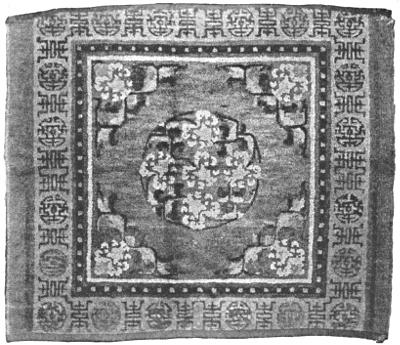
A RUG OF MIXED DESIGNS
The Center Is a Faded Magenta Red. The Border Ground Is Pale Yellow
CHINESE RUGS
By JOHN K. MUMFORD
Author and Expert on Oriental Rugs
DEPARTMENT OF
FINE ARTS
VOLUME 4
NUMBER 2
FIFTEEN CENTS A COPY

No word in the language is more abused than “beauty.” A pretty thing is a thing of beauty; a pretty picture is a picture of beauty; and so following. Lacking a proper descriptive term for anything attractive, we, too often, employ the word “beauty.” What term have we then with which to pay just tribute to true beauty?
The real, final test of beauty is that it wears well—not in a material way, but in the qualities that are truly beautiful. The rose is fragile material and its life is brief, but rose beauty is lasting and rose fragrance clings sweetly to the memory—so that the rose has become a synonym of beauty. The message of true beauty is enduring and, oft repeated, grows in charm. “A thing of beauty is a joy forever.”
A distinguishing attribute of true beauty is authority. A thing of beauty bears on its very forefront the stamp of authority. It does not plead for recognition—it commands it. The snow-capped summit at sundown, the Madonna face on a master’s canvas, the poet’s “lofty rhyme,” the fragrant flower, the harmonious symphony, the “frozen music” of architecture—the countless varied forms of beauty in nature, art and life ask no favor nor do they play to the fancy of the moment. Created in intelligence, sincerity and truth, and inspired by lofty devotion, they compel a lasting homage.
PLATE I

LOANED BY MR. CARLL TUCKER
ANTIQUE CHINESE RUG
CHINESE RUGS
Monograph Number One in The Mentor Reading Course
Length, nine feet nine inches.
Width, five feet five inches.
Forty-two hand-tied knots to the square inch.
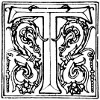
This attractive rug is representative of a very admirable class of Chinese floor fabrics, and illustrates in the clearest manner some interesting and important features in the rug weaving art of China. The knottage, as will be learned from the specification above, is not great. A Mohammedan sedjadeh with only 42 knots to the square inch would be held of small merit, unless it came from one of two or three districts in Asia Minor—Bergamo for example, or else had some individual element of value, such as great age, phenomenal color, or uncommon design. In China, however, as has been pointed out in the accompanying text, high textures are not accounted of large importance.
This rug is not of great antiquity, nor yet is it of very recent manufacture. It might with safety be attributed to the Kien Lung time, or some reign immediately thereafter. The best artistic tenets of Persia—so far as they appertain to rug weaving—have been conscientiously followed. The Mohammedan influence is not difficult to trace, and yet at no time can a foreign or vagrant note be discovered. The rug is thoroughly Chinese, not only in spirit but in every detail. It will bear careful study in the light of what has been said regarding the absorbent and adaptive quality of Chinese art in all ages. The border area is relatively narrow, wherein marked deference is paid to the oldest and best Chinese standards, and for all a distinctly floral character prevails, the utmost simplicity is maintained. It is a notably consistent rug. There is perfect harmony between border and center, and the most perfect manifestation of the Chinese artistic sense, perhaps, lies in the fact that, to the end of preserving simplicity and balance, the weaver has carefully refrained from “cluttering up” the border section with “guard stripes” requiring additional patterns, which in a rug of this character would have been superfluous and therefore disturbing.
Throughout the field of the rug, despite a decidedly ornate touch, there is still a careful avoidance of excess. Only two elements appear—the emblematic butterfly and floral devices, which not only are combined to form the fine medallion, but which, with the utmost refinement of handling, suffice for all the secondary and tertiary constituents of the design.
Referring again to the fidelity with which the Persian theory has been followed, observe that the design works out from a mathematically precise central point, and is built in all directions with perfect equality. Every figure has its exact counterpart on the opposite side; side or end, the balance is preserved even to the corner patterns. Given such impeccable skill in the adjustment of the design, there remains only one test point; namely, the distribution of color. Observe in this regard with what nicety the dainty touches of light and dark blue are balanced against one another, from the central medallion outward; and also how the little note of irregularity which is held of such vital importance by the superstitious Persian, even in his greatest masterpieces, is struck here by employing blue in some of the smaller field devices, butterflies and flowers alike, and omitting it from the corresponding figures at the opposite side.
Herein lies the human charm in the old weaving of Asia, the touch which makes us know the ancient weaver and his thought, across the space of lifetimes.
PREPARED BY THE EDITORIAL STAFF OF THE MENTOR ASSOCIATION
ILLUSTRATION FOR THE MENTOR, VOL. 4, No. 2, SERIAL No. 102
COPYRIGHT, 1916, BY THE MENTOR ASSOCIATION, INC.
PLATE II

ANTIQUE CHINESE RUG
CHINESE RUGS
Monograph Number Two in The Mentor Reading Course
Length, eight feet ten inches.
Width, five feet seven inches.
Thirty hand-tied knots to the square inch.

The student should compare this rug, in all its details, with that reproduced in Plate I, the property of Mr. Carll Tucker. The two fabrics belong practically to the same school, and are not widely separated in period. They have many points in common. Those in which they do not agree are the more important. For many reasons I am inclined to accord the honors to the other rug on the score of age. This piece (Plate II) is in some ways superior in point of color. In treatment, in concept, in artistry, it is not the equal of the rug in Plate I, and yet to look at, it would by most people be considered more beautiful. This is probably due almost wholly to coloring. Something has been said in the accompanying text regarding the yellowish cast given to Chinese reds, and the manner in which the peach and apricot shades are produced by dyeing loose red over fast yellow. The rug in Plate I is an illustration of that trick in dyeing.
This piece (Plate II) is the very rare exception. Its ground color is pure and cool. In certain lights it is almost a shell pink. The years do not reveal in it any trace of fundamental yellow. This rug lacks the exquisite simplicity and refinement of the first. It is richer, in design as well as in color, stronger in key, but nevertheless splendidly consistent. In addition to the warmer color of the center, there is a freer use of both light and dark blues, which however are managed with the greatest skill. There is more vagrancy in design, due to a manifest effort at elaboration. The added border stripe bearing the wave or fret pattern is a necessary contribution made in order to balance the stronger center. The same may be said of the small round medallions in the main border, bearing very ancient symbols of longevity.
After long study of these two rugs, I have come to the conclusion that the design shown in Plate I is a rug design, made for that purpose and no other, and the one here shown, beautiful as it is, was borrowed from the porcelain, perhaps from several vases. There are certain Persian rugs of the 17th and 18th centuries, and many Perso-Indian rugs of a still earlier period, which have something in common with this minute floral type of Chinese design. Which artist, the Mohammedan or the Chinese, was the borrower and which the lender would be difficult to say at this distance.
But all this aside, it is still worthy of note and should never be forgotten in the study of Chinese rugs, that whatever and wherever they borrow they are still Chinese. In this rug (Plate II) there is one concession to the Persian habit, which might better have been omitted for the sake of decorative purity; namely, the conversion of the narrow inner “water” stripes into corner ornaments. Not that the shapes thus obtained are Persian in their character. They are not. On the contrary, they suggest the conventional corner dragons in the oldest Ming rugs, of which a superb example is found in Plate VI. But the manner in which they are brought out is more that of the heavy Chinese teak wood carving, which plays so large a part in the interior decoration of China down to the present day. They add an element of strength to the design; but they distinctly “do not belong,” and constitute therefore an inharmonious factor when considered in the light of cold analysis. None the less, with its superb coloring, the rug is far more beautiful than most that come out of China in these days of rug decadence.
PREPARED BY THE EDITORIAL STAFF OF THE MENTOR ASSOCIATION
ILLUSTRATION FOR THE MENTOR, VOL. 4, No. 2, SERIAL No. 102
COPYRIGHT, 1916, BY THE MENTOR ASSOCIATION, INC.
PLATE III

LOANED BY MR. CHARLES B. ALEXANDER
ROUND CHINESE RUG
CHINESE RUGS
Monograph Number Three in The Mentor Reading Course
Diameter, nine feet nine inches.
Eighty hand-tied knots to the square inch.
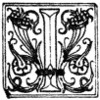
In point of actual age, this very unusual rug is perhaps the youngest of all the six pieces selected for color reproduction with this number of The Mentor. The general observations that have been made regarding the distinguishing characters of the various periods will be forcibly illustrated by comparing this rug with Plate VI, which represents one of the earliest fabrics. The difference between them, from the standpoint of simplicity in design, is decidedly marked, and constitutes an entire lesson on the course of Chinese art. Reserving comment on Plate VI for its proper place, it is interesting to note some of the features of the round rug. Its elaboration must be emphasized first of all. No effort of which the maker was capable has been spared in the purpose to make this a carpet of note. Its shape alone is sufficient proof of this. The circular rugs, whether Chinese or Persian, are extremely rare. The only other one of great importance is an early Ming piece owned by a gentleman living in New York City.
In Plate III, pursuing the comparison suggested above, there should be noted the great complexity of design. In the attempt to create a masterpiece, the weaver has borrowed from all the Chinese decorative schools and periods. He has multiplied borders and employed a world of material for their ornamentation. Dismissing the outer band of blue, which serves as a sort of protection for the rest, examine the main stripe. The various spaces herein, set off in a sort of cartouches after the fashion of Persian borders but nevertheless with a Chinese drawing, are filled with elements of divers sorts. Twelve of them bear the repeating patterns used as ground covering in much older rugs, including the fret or key pattern and the lozenge-shaped diaper, which is commonly supposed to be Indian in its origin and of a very early day. The alternating sections have cloud bands, flowers, and nature symbols such as were copied into the Persian weavings after the invasion of Hulaku Khan, and appear in many of the high-school carpets of Persia of the 15th and 16th centuries. Two, at least, of these alternating sections bear plants in pots, a later decorative form, and purely Chinese. Inside this there is a wave or “Greek” border stripe; not flat, as in the older rugs, but shaded, or in a sort of perspective. This and the stripe which lies inside, between it and the field, with the white spots, on a ground of blue, are believed generally to be indisputably of late origin.
Passing to the center field, the same ambitious profusion is manifest. The ground design is of most composite character; flower stems, potted growths, suggesting the “Hundred Antiques” pattern, and, by way of good measure, certain of the Buddhistic emblems of Happy Augury, notably the “Entrails” or Endless Knot. All these are laid, in various exquisite colorings, upon a field of the softest gold yellow. Passing to the central medallion, yet a new element confronts us in the Foo dogs, of which several are employed, somewhat crowded, and confused by reason of their coloring, which, nevertheless, is good and, so far as balance is concerned, well distributed. These are inclosed by a broad band or wreath of more or less conventionalized flowers. The solidity of this center is for the purpose of offsetting the rather too heavy border section. In this the true workman appears.
Of the coloring, the wool, and the technical skill displayed, only the highest praise is to be spoken. There are few Chinese rugs that surpass this in textile quality.
PREPARED BY THE EDITORIAL STAFF OF THE MENTOR ASSOCIATION
ILLUSTRATION FOR THE MENTOR, VOL. 4, No. 2, SERIAL No. 102
COPYRIGHT, 1916, BY THE MENTOR ASSOCIATION, INC.
PLATE IV

OLD CHINESE RUG
CHINESE RUGS
Monograph Number Four in The Mentor Reading Course
Length, eight feet four inches.
Width, five feet seven inches.
Thirty hand-tied knots to the square inch.

This is what is known as the “grains of rice” pattern. While the reason for this name is obvious, the design is really derived from the “cash”—the familiar Chinese coin with a square hole in the center. In old rugs, where the color has faded, it is difficult to trace the resemblance, but this derivation is vouched for on good authority. The “cash” is a symbol of good luck. It is customary not to fancy this pattern; but the fact remains that it always sells, like the equally repeating “fish pattern” rugs of Persia. It is almost certain that the reason for this is the simplicity and cheerfulness of rugs of this type. The yellow used in them is usually not of the most attractive shade, verging as it does toward the “lemon” and “pale mustard” quality. Altogether, however, it provides a most agreeable background, usually for some figure rather more ornately drawn but usually neat and clean-cut in its effect, as in this instance.
This rug was made somewhat later than Plates I and II, and probably after the time of the Emperor Kien Lung. During that reign more or less elaborate use seems to have been made of foliate floral arrangements, drawn like those seen here in the broader border stripe. From using these patterns in small areas, such as borders or in individual bits upon a plain field, was developed the fashion of covering the entire central area with them, almost always in the same colors,—yellow and blush red. The reds were inclined to fade, and as the rugs grew older they attained wonderful delicacy of tone. Where the “grains of rice” pattern is employed there is, in most cases, a certain quantity of red or pink interpolated in some part of the rug, for the obvious purpose of showing up the somewhat cold, thin yellow, which otherwise would be too weak to be attractive. It is noticed here in the main border, the ground of the inner border with fret pattern, and in the scrolls which inclose the five floral medallions.
For some reason, probably racial, there appears in these “rice pattern” rugs far more often than in any type the “barring” of color—that is to say, a change in the ground color, usually to a lighter shade—so as to form a bar or transverse stripe across the field. This is a common practice among the Kurds in western Persia, who believe that it makes for good luck. Further illustration of this irregularity occurs widely throughout Chinese weavings in the seemingly “hit-or-miss” distribution of many colors, principally the blues in the border patterns. This peculiarity is very well shown in the present example, but is confined to the border section. In the medallions of the field every element seems to have been worked out with the greatest regularity and exactitude.
PREPARED BY THE EDITORIAL STAFF OF THE MENTOR ASSOCIATION
ILLUSTRATION FOR THE MENTOR, VOL. 4, No. 2, SERIAL No. 102
COPYRIGHT, 1916, BY THE MENTOR ASSOCIATION, INC.
PLATE V

OLD CHINESE TEMPLE RUG
CHINESE RUGS
Monograph Number Five in The Mentor Reading Course
Length, ten feet.
Width, eight feet.
Forty-two hand-tied knots to the square inch.
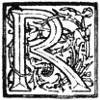
Rugs of this type, which seldom make their way to America, have been attributed to Mongolia. There are reasons for believing that this piece came direct from a temple in the borders of Tibet. It resembles in many ways the now famous rug in the Metropolitan Museum of Art, for which the late J. P. Morgan paid $25,000. Although smaller than the Museum temple carpet, the one here reproduced is superior to it in textile quality and probably in age. Both have the imperial five-clawed dragons of the Ming, contesting over the “jewel” which is one of the Buddhist symbols. Both rugs also have across their lower end the sacred mountains and the sea, depicted in their ancient traditional form. There the resemblance may be said to end. It is in the symbols distributed throughout the field that this rug excels the other from the documentary standpoint. In addition to the cloud and cotyledon figures, with which both rugs are ornamented, this piece contains all the principal symbols of Happy Augury,—the Flaming Wheel, the Sacred Lotus, the Fishes, the Canopy, the Jewel, the State Tent, the Endless Knot, and the Conch Shell. Here appears also, in soft shades of brown, the bat, recognized as a symbol of longevity.
In the top of the rug and extending from one side to the other, is a continuous festoon, made up of conventionalized buds and flowers of the lotus. This appears invariably in rugs woven for the draping of temple pillars, or for religious hangings, and it is never found save in fabrics made for some devotional purpose. It will be noted that this part of the rug, a space about eighteen inches wide, is very much worn. The most likely explanation of this condition is that the rug was used on an altar and that a rail or other barrier prevented the nearer approach of the devotees.
This extraordinary carpet presents the most convincing illustration of what has been said in the text regarding the methods used to secure blush-red shades,—peach, apricot, and the like. In China it is customary to quilt the backs of nearly all small- and medium-sized rugs that are used on floors, benches or kongs (built-in brick heating devices). Oftentimes the cotton cloth used to cover the bats of quilting cotton is brought up over the end of the rug and sewed fast. This piece was brought to America in some haste, and the quilting was not removed until after it arrived here. When it was taken off, the original color was revealed. It may be seen in the color plate, a brilliant stripe across the lower end of the rug.
People are often misled by the absence of border from certain Chinese rugs, into the belief that they are not intact. This is of course an error, and it is worthy of note that the Sacred rugs, containing in their designs a high measure of religious symbolism, are almost invariably without borders.
PREPARED BY THE EDITORIAL STAFF OF THE MENTOR ASSOCIATION
ILLUSTRATION FOR THE MENTOR, VOL. 4, No. 2, SERIAL No. 102
COPYRIGHT, 1916, BY THE MENTOR ASSOCIATION, INC.
PLATE VI

VERY EARLY CHINESE RUG
CHINESE RUGS
Monograph Number Six in The Mentor Reading Course
Length, nine feet nine inches.
Width, six feet six inches.
Sixteen hand-tied knots to the square inch, double yarns.

It should be, and probably will be, unnecessary to write any words of praise for the wonderful old carpet so well reproduced in this plate. It has all the marks of great and genuine antiquity. It represents the Chinese rug-weaving art at its best, so far as clear concept, perfect simplicity, and balance go, and the marvelous color which distinguishes the highest expression. When this piece came to America, together with the temple carpet shown in Plate V, it was in a sorry state of disrepair, although but little of the original web was missing. The work of reparation occupied a very considerable period of time, but resulted in bringing back to life and utility one of the most perfect examples of early weaving that have ever been imported.
If praise of the rug is unnecessary, analysis of it is next to impossible, for the good reason that there is nothing much to analyze. In color there are only two shades of tan, one gold, the other brown, and the one shade of very peculiar, misty blue. These, together with the wide band of dark brown around the sides and ends, all softened by age, complete the narrowest color schedule it could well be possible to employ in a rug. The range of design is still more limited. There is nothing but the fret in the central medallion and the single border, and the small medallions and corners, which, while not pretending to actual depiction, even conventionally, are nevertheless doubtless derived from the simple dragon forms so widely used at the remote period when this rug was made. In all this there is nothing complex, nothing pretentious, and yet the whole has a decorative atmosphere, and a completeness, which could not have been more impressive and which a free use of divers patterns could only have impaired.
From the standpoint of composition, particular attention should be paid to this blue. The color printing process has fortunately reproduced it with astonishing fidelity. It is not alone unique among the multitude of wonderful blues in which the old Chinese dyers excelled, but it would be difficult for the most skilful of present day colorists to have selected or devised a shade which would have taken its place in complementing to the shades of gold brown which dominate the entire fabric. In the light of such an accomplishment, it is difficult to believe that the scientific theory of color was worked out by a Frenchman, at so very late a day.
Some importance, finally, attaches to the brown band formed around the outside of the rug. Wide observation of old Chinese rugs reveals the fact that brown, used for this purpose, is an almost unfailing mark of very early origin. As time went on, blue began to supersede it, and through recent centuries the blue band has been well nigh universal; though in some few localities, apparently, brown has been adhered to for this purpose, down to a comparatively late day.
PREPARED BY THE EDITORIAL STAFF OF THE MENTOR ASSOCIATION
ILLUSTRATION FOR THE MENTOR, VOL. 4, No. 2, SERIAL No. 102
COPYRIGHT, 1916, BY THE MENTOR ASSOCIATION, INC.
By JOHN KIMBERLY MUMFORD
Author and Expert on Rugs
COLOR PLATES
ANTIQUE CHINESE RUG
ANTIQUE CHINESE RUG
ROUND CHINESE RUG
COLOR PLATES
OLD CHINESE RUG
OLD CHINESE TEMPLE RUG
VERY EARLY CHINESE RUG
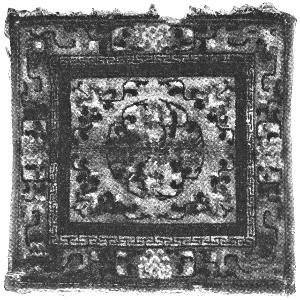
A VERY CONSISTENT DESIGN
Center and border have a single motive. The fret and spot stripes furnish the accent
THE MENTOR · DEPARTMENT OF FINE ARTS
MARCH 1, 1916
Entered at the Post-office at New York, N. Y., as second-class matter. Copyright, 1916, by The Mentor Association, Inc.
There are many reasons for believing that the weaving of rugs was not indigenous to China, but was borrowed, perhaps a very long time ago, from Persia, or, possibly even earlier, from the Turkomans, to whom has generally been attributed the invention of the piled or upstanding knot. Recent investigations lead one to disbelieve in this, and to consider even these ancient Turkomans as more or less modern. But they nevertheless confirm the belief that rug weaving was an acquired art with the Chinese. This conviction is further sustained by the relatively small part rugs or rug weaving have had in the Chinese artistic tradition, the absence of reference to them in literature, and the fewness of fine Chinese rugs as compared with the multitude of wonderful pieces that have emanated from Persia, Turkestan, India, and Turkey.
In China rugs do not appear to have been so much a part of the daily, intimate life of the people as they are and always have been in the Moslem countries, nor have they received so much of reverent attention. True, much of Chinese religious symbolism has been woven into the rugs, but chiefly in the few special pieces made for the ornamentation or furnishing of the temples. The Mohammedan’s rug is closely related to his daily devotions. In China the rug has no such place, but is in the main a utility; and for this reason, perhaps, efforts to produce masterpieces have been far fewer in China, and there appears to have been no record or tradition of individual weavers of renown. In only a few instances is there found in Chinese rugs the studious and wonderful elaboration displayed, for example, in the sixteenth-century Persian rugs, the fine fabrics of old Damascus, or the superlative weavings of the Perso-Indian artists.
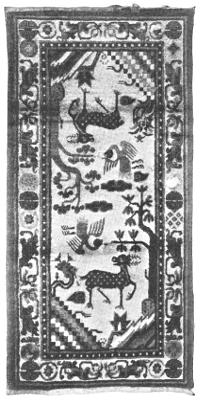
A VERY AMBITIOUS DESIGN
The garden idea is apparent. The deer, stork, tree, and cotyledon (seed leaf) forms are of the “Shou” order suggestive of long life. The round fret forms at the corners likewise symbolize this
The art of China, as expressed in porcelain and in painting, took hold upon the fancy of the West long ago: witness the Delft ware, which of course owes its inspiration to Chinese sources. Europe had a passable notion of Chinese artistic tenets at a rather early period. So, relatively, had America. It is interesting to note that of the Chinese rugs, now so amazingly popular in this country, practically nothing was known until fifteen or twenty years ago, save to an exceedingly small number of people. The period of their predominance in popular favor has been brief; but already the supply of old pieces with real merit is exhausted, particularly in the larger sizes.
The vogue of the Chinese rug in this country is unquestionably due to the artistic sense and discernment of the late Stanford White. In a certain establishment in New York there had grown up an accumulation of old Chinese pieces, some of them very rare and beautiful, which had been “thrown in” with other art objects purchased. They begged for attention at thirty or forty dollars each, until Mr. White placed one or two of them in the hall of the late William C. Whitney’s house. From that moment the demand for them, and consequently their market value, advanced at a prodigious rate.
No matter what anybody may claim, it is doubtful if there has ever been in Europe or America any definite or systematized knowledge of the locality of origin or the period of Chinese rugs. Aside from the small importance usually attached to them as art products by the Chinese themselves, this dearth of specific knowledge has been due to the fact that the rugs were not woven in Eastern China, but in the interior provinces, and, even after a demand arose for them in the West, buyers were well content to await arrivals in the Treaty Ports, rather than court the perils of travel into the Chinese hinterland. It was believed that as soon as the demand became known there would be great influx of desirable fabrics to Peking. There was; but it lasted only for a little space, and today in the Chinese capital a rug of any merit whatsoever commands a price almost prohibitive. This has led to a great volume of manufacture in Peking, both in new designs and in more or less creditable copies of the old. But so violently has this commercial production been promoted that the very multitude of modern Chinese rugs has begun to work injury to the enterprise; although the texture of the new rugs is finer than that in many of the old ones. In fact, Chinese rug weaving as a whole does not show any impressively high measure of technical accomplishment.
The texture of Chinese floor coverings is usually far coarser than the Persian, or even the Turkish, notwithstanding that they are woven in the Persian knot, which lends itself to amazing fineness of detail. In addition to this coarseness a very heavy weft or cross-thread is used, sometimes four heavy strands after each transverse row of knots. This results in a very flat “lie” of the pile. The difference between this and the fine, almost perpendicular pile found in the rugs of Ispahan (so-called) of Tabriz and of Kashan, is striking; but it doubtless expresses the general attitude of the Chinese toward the rug. They evidently regarded it merely as a medium for the presentation of simple patterns and broad masses of color, and the quickest method of securing these was the best.
Chinese rug design and treatment are plainly impressionistic, as contrasted with the infinite detail that marks the high-school weavings of Persia.

COVERING FOR A CHAIR SEAT AND BACK
This fabric is in yellow and blue. The sacred mountain is the chief feature of the design
The Chinese weaver adapted the method to his requirements, and some of the most beautiful effects in the Chinese fabrics are found in absurdly coarse specimens. On the other hand, when he did undertake finer accomplishments, he vindicated all the high artistic traditions of his race. Perhaps the most impressive illustration of the racial skill and deftness is the cut work with which, in the better rugs, many of the patterns are outlined. This consists in the seemingly simple device of cutting away half the knot along the lines of a pattern; such, for example, as a flower or vine, a wave or a bird. The result is to leave the pattern clearly defined and in actual relief, without the interjection of another color. This cutting takes the place of the color outline almost universally used in Persia. In this, as in almost every phase of artistic accomplishment, the Chinese individuality and conservatism are manifest.
When we consider Chinese history and note the multitude of race factors that have gone into China-Arabs, Jews, Nestorians, Hindus, Armenians, and Turks, the wonder is that the Chinese weaving art is not manifestly and obtrusively composite; that is to say, that it does not show on its surface these various elements. But, on the contrary, it has taken the “busy” patterns of the races farther west, stripped them of their masses of confusing detail, and imbued them with the dignity and indefinable calm which seems to be the inevitable Chinese mark.
Anyone familiar with rugs can discern, in a certain school of Chinese fabrics, the Persian characteristics as found in the rugs of Khorassan; but always, and from whatever source derived, these patterns have been touched with the purely Chinese character, laid in the Chinese color, and so in the course of time have become thoroughly localized. China converted the hard octagons of the Turkoman rugs into circular scrolls or medallions, beautifying them meanwhile with some floral character manifestly borrowed from the Persians—and yet by no means Persian. There has been in all the world probably no more perfect example of racial individuality in art.
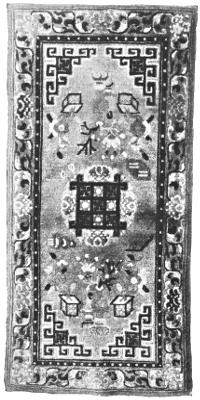
A COMPOSITE DESIGN
Of a rather late period. In the border are found somewhat overloaded Mohammedan characteristics
It should be said, however, that Chinese influence has been equally effective outside its own pale. In the thirteenth century, Hulaku Khan, leading his Mongol hordes in conquest, took Chinese artists and workmen as far west as Bagdad. Traces of this transportation may be found in a great many Persian and Turkish rugs, particularly the palace pieces made for three hundred years after that time. The so-called “cloud band” and the cotyledon symbol (representing the life idea) may be seen in many fine Persian rugs. The dragon, which plays so large a part in Chinese ornament, has also been imparted to other races. The best illustration of this is the large Bagdad carpet from the Yerkes Collection, now in the Metropolitan Museum of Art.
In eliminating the overactive quality in Persian design, China made use of “background” in a way which the most advanced theorists in artistic composition must approve. The field of plain color became paramount; but it was rarely used, in the best early periods, as it is in the West, as a hard, defined area with central medallion and corner spaces. Where this was done the softest color was used throughout, such as a golden brown, relieved by dull blues and perhaps a deeper brown or a touch of gold yellow. In by far the most cases the pattern is distributed over the field sparsely instead of densely as in so many of the Persian rugs. Almost the only exceptions to this rule are small, repetitious diaper patterns, usually in mild coloring. Generally speaking, the patterns in Chinese rugs are large in proportion to the fabric; but it will be noticed that each has a more distinctive value. The natural effect of this would have been excessive strength in general effect; but here again the Chinese art intuition rose to the requirement. The difficulty was obviated by an entire change of color scheme.
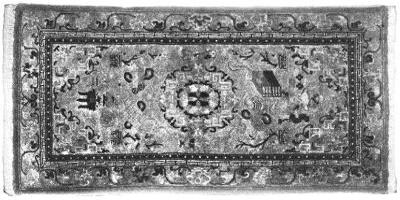
A RUG OF UNUSUAL QUALITY, TEXTURE AND COLOR
The strength of the patterns is well distributed
While the Chinese of early times were master color makers, a very narrow schedule of colors has always served for the rugs, until the later decadent periods; in fact, this holds true in all Chinese art. There is in the entire kingdom of Chinese rug weaving no such jumble of unrelated colors as we find in the Persians. I have had occasion heretofore to make clear the Persian theory of color, that of neutralization by juxtaposition, in which a score of naturally conflicting colors are thrown together with great freedom, with the purpose that they shall neutralize one another. The Chinese had a concept more nearly approaching our own. He dealt in simple colors rather than in complex ones, and what neutralizations he accomplished were done before the actual weaving or else effected by the fading of the dyes after the rug was completed. In Chinese rugs art takes precedence of workmanship, and as the art declines, in the moderns, the texture seems to improve.

AN OLD RUG IN GRAY AND SOFT BROWN COLORS
Simple and effective. The lattice ground of the border has been used very intelligently
With this wide view of the Chinese habit and tendency before us, it is well to consider the all important matter of color. The range of coloring is noticeably narrow and correspondingly simple; though at first glance it does not always seem to be so. To this fact is doubtless due the restfulness which is the great charm of Chinese rugs. There are, to be sure, designs which are to the Western eye hard and discordant; but it will be found that most of these are in rugs of a religious sort, where the patterns include the dragons, Foo dogs, and other symbolic devices which seem to us grotesque and even repellent. It will be observed, however, when one has acquired familiarity with the Chinese rugs, that the adjustment of color values is most accurate, always bearing in mind that the Chinese seem to have discounted in the oldest and best periods of artistic production the mellowing influence of time.

A COHERENT AND WELL BALANCED DESIGN
The colors are blue and white
Most noticeable in Chinese rug coloring is the wonderful scope and quality of the blues. The highest expression of Persian skill in dyeing has always been found in blue; but even in this art—which, by the way, the Persians have now in a great measure lost—they must yield place to the Chinese. In the older rugs the Chinese blues show a range, a depth, and a luminous quality which are not surpassed in the world, and even the best modern pieces now being produced in Peking are in this respect superior to their Persian contemporaries.
Second, certainly, to the blues in importance come the yellows. While yellow has been used freely in Persian rugs, and more so in those of Kurdistan and Asia Minor, the fact of its royal and semi-religious value in China has caused it to be employed in some of the Chinese fabrics with a frankness not equaled elsewhere. Twenty years ago, before popular taste in America had attained its present appreciative attitude toward all Chinese art, the prevalence of yellow in strong values and large areas in the rugs was one of the chief causes of American dislike for them. It is unpleasant to admit this now, when old Chinese rugs in yellow, and some not so old, are sought with an avidity that disregards the question of price.
Since Chinese rugs have come into demand we have heard a great deal of “imperial yellow.” Almost any yellow is “imperial” when a sale hangs in the balance. But it should be unnecessary to say that true imperial yellow is quite as rare in Chinese rugs as are imperial persons among the 400,000,000 of Chinese population. Its actual frequency is about equal to that of “inscriptions from the Koran in the modern rugs of Persia.” To describe it would tax the skill of Lafcadio Hearn, who would not have been so rash as to undertake it. Perhaps the most descriptive thing one can say is that it outyellows all the gold that ever shone.
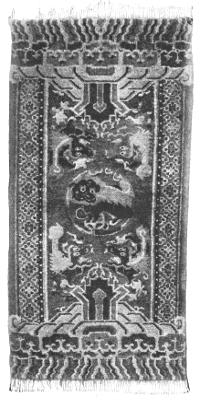
INHARMONIOUS DESIGN
It is too strong for a small fabric. The sacred mountain and the Foo dogs are combined badly with a border stripe derived from India or Khorassan
The green schedule is very limited and the employment of green even more uncommon than in Moslem countries, where its religious importance restricts its use. When green does occur in Chinese fabrics, it has usually an admixture of yellow which converts it to olive, or else is a frank attempt to reproduce the color of jade. The colorings of old Chinese rugs, in the order of their frequency, are about as follows:
1. Blue and white, with the pattern in two or even three shades of blue, on white background, or occasionally with a splash of some salmon shade to give warmth and accent.
2. Reds and pinks, with design in two blues, yellow, tan, and white.
3. Yellow and blue, yellow ground with design in two shades of blue, with admixture of white and secondary elements in soft shades of tan and brown.
4. Browns and fawns, with patterns in blues, white, red, or yellow.
5. Dark blues, with design in white, or far less frequently in gold tan, relieved by small bits of light blue and white, sometimes one note of rust red for luck. (This seems to be common in all parts of Asia.)
6. Light blues, with pattern in white and the softer shades of yellow, pink, and fawn or brown, and small display of dark blue.
7. Green grounds, usually olive, with pattern in dark and light blue, yellow, and some red.
There are some other eccentric colorings, but these are the chief. The blue and white pieces are scarce now for the reason that they contribute to the “cool effects,” the attainment of which has of late been one of the chief aims of the highest practitioners in the art of decoration. The reds and certain “mustardy” shades of yellow have perhaps been least liked and linger longest on the shelf. Blue or yellow has proved a more attractive color arrangement. The dark blue and light blue grounds have always been very rare, and a green rug is an episode.
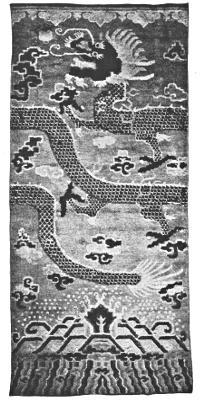
A TEMPLE FABRIC
When fastened around a pillar the dragon is complete and appears twined spirally
Red appears in Chinese silks in clear tones. In the rugs it almost always has a yellowish cast. There are many shades of salmon pink and red, but very few pieces with pink of a cool character, such as the “shell” shades, rose pink, or the famous Du Barry. All these appear in Persian and Kurdish rugs, and to one knowing how infinitely skilful Chinese dyers have been it is at first hard to understand why the schedules of this common and popular color included chiefly the yellowish tints, from pale apricot to a deep red which nevertheless verged toward orange. The reason for it is still difficult to discern: the method of obtaining these shades, in a softness which increases with age, is now clear.
If a Persian dyer wished to secure any particular shade of color, he would mix his dyes to that end, and the color, when applied, would remain. The oldtime Chinese dyer was more ingenious. He dyed the wool first in a fast yellow. When this was dry and thoroughly set it was dipped into a rather strong red, more or less fugitive. Upon long exposure to the air the red faded and the yellow came through; enough of the red remaining to leave the degree of warmth desired. The delicacy of these colors increases with age. In some old pieces, obviously of the Ming period, the wool which was originally red has come down to pale gold, with only the faintest blush over it, and in the faded color there is a quality which no accurate one-color dying can give. The Chinese dyer evidently counted upon the softening effect of the years, a foresight which could be found nowhere save among a race of collectors.
The simplicity which distinguishes Chinese coloring may be said equally to distinguish the design. This is more true of the old fabrics than of those of later origin. In fact, one of the distinguishing marks of the old rugs is the use of very simple patterns and usually a narrow border, consisting of some form of the fret or wave pattern which in architecture is known as “Greek,” but which appears with the swastika (卐), of which it is a clear development, in the primitive art of all races, and which in China has been employed most freely from the earliest times.
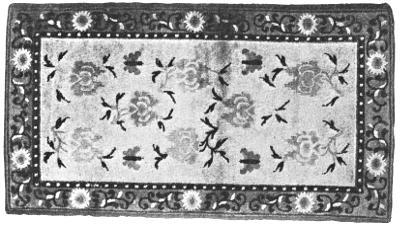
A RUG CONSISTENT IN ITS STRICTLY FLORAL CHARACTER
Well balanced, and modelled after the Kien Lung designs, but probably made later. The color effect is sprightly
Just when or at what stage of Chinese religious culture the dragon came into Chinese art we probably do not know; but it is found in the earliest rugs we have trace of. In these, however, it shares the prevailing simplicity, is strictly conventional in character, usually laid in blue and worked into the shape of a circular medallion, or sometimes, in conjunction with the fret, into corner devices. These, however, seem to have been appropriated from the Persian along with the central medallion.

MAT OF A VERY EARLY PERIOD
The purest of designs in gold and brown
As time and the art progressed there crept into the design a greater opulence, a higher degree of elaboration. Something of the floral richness of Persia was absorbed, and it abides to this day; but everything adopted was transformed, in color and treatment, to fit into the Chinese decorative scheme. Instead of a profuse mass of floral material, one flower was taken as a motive and presented in repeating fashion, duly emphasized, and with no multiplicity of other floral factors to detract from it. In almost every case the flower had an ethical or religious meaning which became the keynote of the rug.
In this connection it may be said that there is no art in the world in which so great a part of the prevailing figures has a generally recognized symbolic meaning.
Very comprehensive is this symbolism. It includes not alone a multitude of things from the floral and animal kingdoms, but even certain utensils had a meaning; social, ethical, or moral, if not religious. The bat, the bird, the butterfly, the dragon, the kylin, the Foo dog, the leopard, the elephant, the horse, the phœnix, the stork,—the list is altogether too long to permit of any thorough tabulation. The old symbols of primitive religion, found in Turanian rugs and dating back to the very morning of mankind, do not seem to appear in the Chinese weavings; but it is manifest that somewhere, at some time, the Chinese symbols and their attendant meanings were derived directly from some imaginative form of nature worship (witness the cotyledon or seed germ, which was adopted by Persia from China and appears so often in the high-school Persian rugs of Sefavian times). The meanings, once established, have been maintained in popular understanding. Every intelligent Chinaman today knows them as his remote ancestors did. It is a part of the great fund of popular information that bird, bat, deer, and butterfly convey wishes for long life and good fortune.
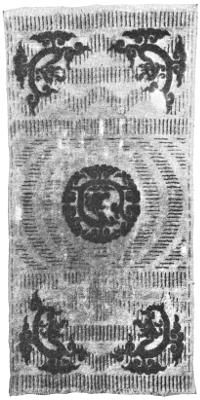
ONE OF THE OLDEST AND FINEST EXAMPLES OF CHINESE RUGS
The dragons at the center and the corners are in marvellous blue on a background of pure gold. The “tiger” marks are in brown
Chinese symbolism has developed some eccentric and even egregious things; such, for example, as the dragon and the kylin. Each and every of such impossible creatures had his sphere and his legend. Of the dragons, there are several kinds,—one of the heavens, one of the mountains, one of the sea. The emperor’s dragon has five claws. So has that of the first- and second-class princes. The next two classes of the royal family may display only a four-clawed one; while ordinary mortals must be content with three. A four-clawed serpent bespeaks a mandarin or a prince of the fifth rank.

AN UNUSUAL SADDLE CLOTH
It has religious symbols in the center on a yellow background. The border shows Hindu influence. The coloring is splendid
The kylin, a fearsome four-footed beast, means long life and good government. The phœnix, in addition to his indestructible life, was reputed to live high in the air, and to descend to earth only as the bearer of good news. The catalogue is endless, and perhaps to the Occidental useless, unless it be for the information of the collector or to divert the curious mind.
Many of the superstitions common in Turkey and Persia, seem to prevail throughout China. For example, I have found a “cash” (perforated Chinese coin) sewed fast to an old Chinese rug to bring good luck. It should be noted that the “cash” is one of the Buddhistic “symbols of happy augury.” Few people in any part of the world will fail to see the fitness of this. The Mohammedans indulge this same practice, using sometimes a gay bead or a scrap of cloth.
In weaving rugs the Chinese in earlier times had one custom of which I have found no trace in western Asia; namely, that of weaving a rug in two, three, or four sections, breaking an elaborate design without respect for its continuity, and knitting the parts together by the warp threads, evidently to produce just the required size. This is most prevalent in large temple rugs.
A word should be said concerning the assigning of rugs to specific periods. There are persons who will name a period for any Chinese rug. I believe more of these are wrong than right. There are some rugs which present coloring or design of distinct period character, and in general it is probable that the earliest are the simplest. The poor old Ming dynasty has had an awful burden to carry. Ability to tell when any and every rug was made would imply an intimate and detailed familiarity with the civil and artistic history of China for unnumbered years, and the person who professes such knowledge should be ready to give a reason for the faith that is in him. Not too much is known about Chinese rugs. They offer an ideal field for the ambitious student, and when he has mastered it thoroughly he will know much besides rugs.
There is a scarcity of literature dealing with Chinese rugs. A knowledge of Chinese rugs is based on a knowledge of rugs in the general Asiatic sense, and on Chinese art in all its developments.
| CHINESE ART | By Stephen W. Bushell |
| London, 1910. Chap. V, “Textiles, Woven Silks, etc.” | |
| CHINESE PICTORIAL ART | By Herbert A. Giles |
| Shanghai, 1905. | |
| CHINESE POTTERY AND PORCELAIN | By R. L. Hobson |
| Two Volumes. | |
| BULLETIN OF THE METROPOLITAN MUSEUM OF ART | |
| February, 1909. | |
| L’ART CHINOIS | By M. Paleologue |
| Paris, 1888. | |
| CHINESISCHE KUNST GESCHICHTE | By O. Münsterberg |
| Esslingen, 1912. | |
| THE TIFFANY STUDIOS COLLECTION OF ANTIQUE CHINESE RUGS | By Mrs. M. C. Ripley |
| New York, 1908. | |
| ORIENTAL RUGS BEFORE 1800 | By F. Martin |
| London, 1909. | |
| ORIENTAL RUGS ANTIQUE AND MODERN | By W. A. Hawley |
| New York, 1913. | |
| THE FLIGHT OF THE DRAGON | By Binyon |
| London, 1908. | |
| EPOCHS OF CHINESE ART | By Ernest F. Fenellosa |
| New York, 1913. |
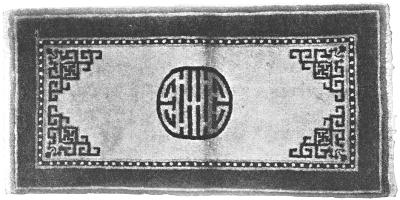
A RUG OF EARLY DESIGN
It is of heavy quality, dignified, and harmonious, in brown and gray colors. The device in the center is a symbol standing for long life
It is a curious fact that, while China is the oldest nation that we know, and the history of her civilization stretches back to the early morning of time, there are many interesting Chinese things with which we have only in recent years become familiar. The Chinese rug is a case in point. How long the Chinese have been making fine rugs no one can tell. It is safe, however, to say that, like their other arts, Chinese rugmaking is of very great antiquity.
And yet, as Mr. Mumford points out, the Chinese rug has come into vogue in the west only within the past fifteen or twenty years. It is true the vogue was anticipated by a few collectors in England and America, but they can be numbered on the fingers of one hand. Mr. H. O. Havemeyer, some twenty-five years ago, took a fancy to Chinese rugs and made quite a collection of them. They had no special market value then, for they were not sought after. Mr. Havemeyer collected them because he was attracted to them as unusual products of the loom, and then because, he found them to be an interesting and profitable subject of study. His collection is no doubt in the possession of his family today, and if a present day value were set upon those rugs they would probably show an appreciation over their original prices of fully a thousand per cent, if not more.
Mr. Mumford calls attention to the fact that the Chinese rug was made popular in this country by the late Mr. Stanford White. Mr. White was a very strong and original figure in art. He did not look to others for suggestions. He led the way and others followed. So when he picked out a number of old Chinese rugs that he found in a New York shop and placed them in Mr. William C. Whitney’s house, connoisseurs and collectors took notice and very soon the Chinese rug became the vogue. All that were to be had in America were soon bought up and the prices rose sensationally. Some time ago a New York collector bought a Chinese rug for $30. This was in the days before the vogue. Two years later he found a mate to this rug in the same shop, ordered it without hesitation—and it was delivered to him with a bill for $3,600. This shows the increase of value that can be effected by a quick growth in demand. And today few genuine old Chinese rugs can be had at any price.

W. D. Moffat
Editor
The Mentor Association
ESTABLISHED FOR THE DEVELOPMENT OF A POPULAR INTEREST IN ART, LITERATURE, SCIENCE, HISTORY, NATURE, AND TRAVEL
THE ADVISORY BOARD
The purpose of The Mentor Association is to give its members, in an interesting and attractive way, the information in various fields of knowledge which everybody wants to have. The information is imparted by interesting reading matter, prepared under the direction of leading authorities, and by beautiful pictures, produced by the most highly perfected modern processes.
THE MENTOR IS PUBLISHED TWICE A MONTH
SUBSCRIPTION, THREE DOLLARS A YEAR. FOREIGN POSTAGE 75 CENTS EXTRA. CANADIAN POSTAGE 50 CENTS EXTRA. SINGLE COPIES FIFTEEN CENTS. PRESIDENT, THOMAS H. BECK; VICE-PRESIDENT, WALTER P. TEN EYCK; SECRETARY, W. D. MOFFAT; TREASURER, ROBERT M. DONALDSON; ASST. TREASURER AND ASST. SECRETARY, J. S. CAMPBELL
COMPLETE YOUR MENTOR LIBRARY
Subscriptions always begin with the current issue. The following numbers of The Mentor Course, already issued, will be sent postpaid at the rate of fifteen cents each.
Volume 2
Volume 3
Volume 4
NUMBERS TO FOLLOW
Mar. 15. THE WAR OF 1812.
By Albert Bushnell Hart, Professor of Government, Harvard University.
This number is one of the series “America In Story and Picture.” It follows “Fathers Of The Constitution,” and will tell in an entertaining manner of all the interesting events that took place before, during, and shortly after the War of 1812.
April 1. GREAT ART GALLERIES OF THE WORLD—THE NATIONAL GALLERY, LONDON
By Professor John C. Van Dyke.
This number continues the series on the Great Art Galleries of the World, of which that on the Louvre at Paris, was the first. This number, will, if possible, be even more beautiful and interesting. Many of the works of the great masters will be reproduced. Professor Van Dyke’s text is as entertaining as it is instructive.
THE MENTOR ASSOCIATION, Inc.
52 EAST 19th STREET, NEW YORK, N. Y.
THE MENTOR
THE MENTOR AS A REFERENCE LIBRARY
Every number of The Mentor is valuable. The back numbers are as useful and entertaining at any time as on the date of publication. Therefore, many members wish to own a complete file of back numbers.
For those who own a complete set and desire to use The Mentor as a reference library, we have provided a simple and convenient method of filing and cataloguing The Mentor. In a booklet which we have especially provided for our members, the various Mentors are grouped under headings which link similar numbers together in sets. Attached to the name of each Mentor is a list of the gravure pictures accompanying it, together with a short synopsis of the contents. This gives immediate information as to what each Mentor contains. We will be glad to send this booklet free of charge.
We also provide for our members file boxes the size of The Mentor. These are furnished stamped in gold lettering for forty cents apiece. In these The Mentors may be grouped according to sets.
We also supply a binder which holds twelve or thirteen Mentors and has proved satisfactory in every way. This binder has been arranged so as to hold The Mentor complete, and it has tie-pins to which the pictures are attached, so that they swing freely in their place and the pictures can be enjoyed as well as the text on the back. The price of these binders is one dollar each.
When our members desire to refer to a picture or look up a fact, it is only necessary for them to consult the booklet, finding there in which Mentor the information may be sought.
The price of all back numbers of The Mentor is fifteen cents each.
Write and let us explain the plan more fully.
THE MENTOR ASSOCIATION, INC.
52 East Nineteenth Street—New York City, N. Y.
MAKE THE SPARE
MOMENT COUNT
